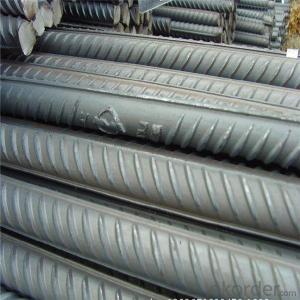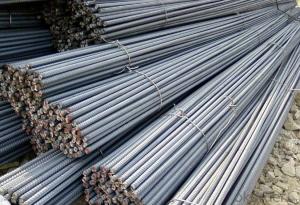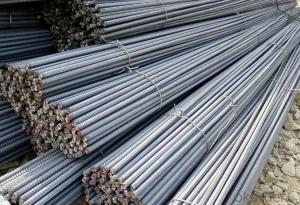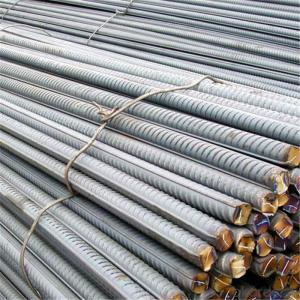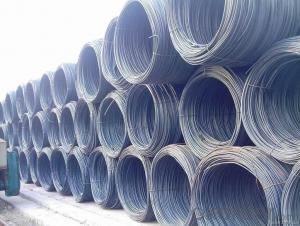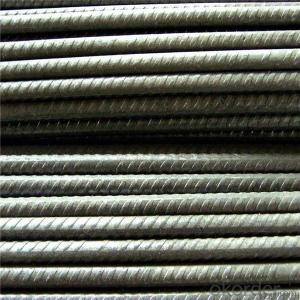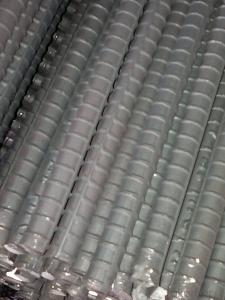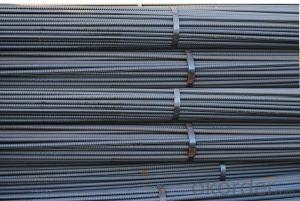Iron rods for construction concrete for building metal
- Loading Port:
- Tianjin
- Payment Terms:
- TT OR LC
- Min Order Qty:
- 1000 m.t.
- Supply Capability:
- 17497 m.t./month
OKorder Service Pledge
OKorder Financial Service
You Might Also Like
Specification
bars of steel commonly used in construction, especially for reinforcing concrete structures such as driveways,
foundations, walls, and columns. These bars come in different sizes and strength grades, and can be smooth
or may include deformations that provide greater adhesion for concrete poured over the bars. When used in poured
concrete, the bars are typically placed in a grid pattern, the concrete poured over them, and then readjusted to
maintain the proper shape while the concrete sets. Steel rebar can be purchased from a number of manufacturers
and is often found at construction retailers or large hardware stores
Product Description :
Chemical composition (%): | Steel | C | Si | Mn | P | S | Ceq | ||||
HRB335 |
0.25 |
0.80 |
1.60 |
0.045 |
0.045 | 0.52 | |||||
HRB400 | 0.54 | ||||||||||
HRB500 | 0.55 | ||||||||||
Mechanical properties | Steel | Rel/ MPa | Rm/ MPa | A/ % | Agt/ % | ||||||
≥ | |||||||||||
HRB335 | 335 | 455 | 17 |
7.5 | |||||||
HRB400 | 400 | 540 | 16 | ||||||||
HRB500 | 500 | 630 | 15 | ||||||||
Package: | Standard export packing or as customer's request | ||||||||||
Application: | Construction, building, bridge, road. ect | ||||||||||
Payment terms | 1).100% irrevocable L/C at sight. | ||||||||||
Delivery time | 15-30 days after receipt of L/C or deposit by T/T | ||||||||||
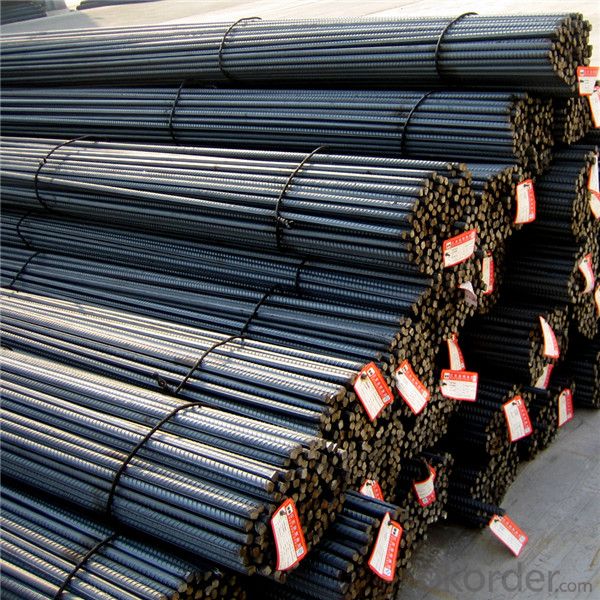
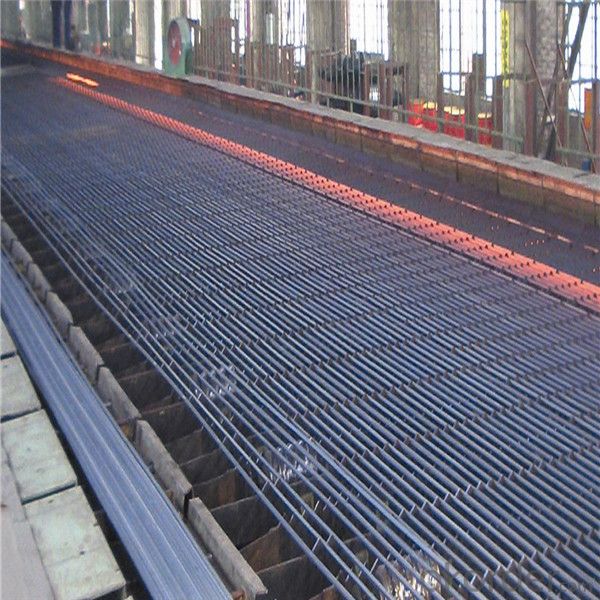
Features
1、Pure steel quality, stable chemical contents, small tolerance.
2、Constant Quality, good drawing performance.
3、High dimension accuracy degree, accuracy degree of Level C up to 80%, smooth surface, less scale, easy to be pickled.
4、Automatic bundling with 4 lines by Machine in tidy and good looks
5、Big high quality percentage, small coil percentage, and heavy coil weight for Hard Coil.
6、High sorbitizing percentage.
Packing:
In bundles, each bundle weight 3.5 tons. Load by container or by bulk verssel.
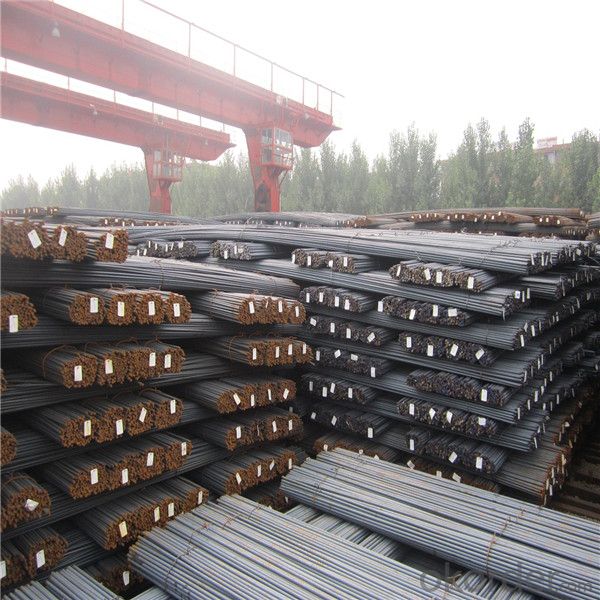
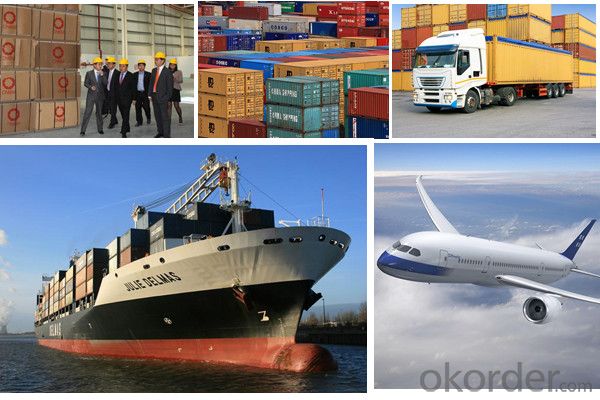
FAQ:
1.Q: What's your MOQ(minimum order quantity)?
A: One full container, mixed acceptable .
2. Q: What's your packing methods?
A: Packed in bundle or bulk ..
3. Q: How can I buy CNBM products in my country?
A:Please send us an inquiry or email ,we will reply to you if there is distributor in your country
4. Q: Can we visit your factory?
A: Warmly welcome. Once we have your schedule, we will arrange the professional sales team to follow up your case.
5. Q: How long does it take to get the product if i place an order?
A:With the process of your requirements,we will pack and deliver in 3-7 days. If it is by sea shipment,it will take 15-45 days depending on different locations
- Q: How do steel rebars prevent cracks and structural failures?
- Steel rebars prevent cracks and structural failures by providing reinforcement and enhancing the strength of concrete. When embedded in concrete, rebars act as a framework that helps distribute the load evenly, reducing stress concentrations and preventing the formation of cracks. This reinforcement ensures that the concrete structure can withstand external forces, such as heavy loads or seismic activity, thereby minimizing the risk of structural failures.
- Q: What is the role of steel rebars in minimizing the risk of structural collapse?
- Steel rebars are of utmost importance in reducing the likelihood of structural collapse in buildings and other construction projects. These rebars, which are commonly referred to as reinforcing bars, are manufactured from steel and are employed to strengthen concrete structures. They augment the concrete's strength and durability, making it more resilient against various forces and decreasing the chances of collapse. One of the primary causes of structural failure lies in the incapability of a building or structure to withstand the forces it encounters. These forces encompass the weight of the structure itself, as well as external forces like wind, earthquakes, and even human activities. Without adequate reinforcement, concrete alone may not have the capacity to endure these forces, thus leading to structural collapse. Strategically positioned within the concrete, steel rebars bolster its tensile strength. While concrete boasts great strength in compression, it is relatively weak in tension. By incorporating steel rebars, the concrete becomes significantly more resistant to tension and can better endure bending and cracking. This reinforcement enables the structure to distribute loads more evenly and prevents localized failures. Furthermore, steel rebars also serve to control and restrict the spread of cracks within the concrete. In the event of crack formation, the rebars function as a barrier, holding the concrete together and preventing further cracking and potential collapse. This role is particularly crucial in regions prone to seismic activities, as the rebars can aid in dissipating and absorbing the energy generated by an earthquake. Aside from their structural function, steel rebars also contribute to the longevity and durability of the concrete structure. By reinforcing the concrete, the rebars help to impede corrosion and degradation caused by environmental factors such as moisture and chemicals. This ensures the integrity and stability of the structure over an extended period, diminishing the risk of collapse due to deterioration. To summarize, the role of steel rebars in minimizing the risk of structural collapse is pivotal. They enhance the strength and durability of the concrete, heightening its ability to withstand various forces and averting failure. Through reinforcing the concrete, rebars distribute loads, regulate crack propagation, and contribute to the structure's longevity, ultimately guaranteeing the safety and stability of buildings and other construction projects.
- Q: What are the guidelines for spacing and positioning steel rebars in concrete structures?
- The guidelines for spacing and positioning steel rebars in concrete structures are critical to ensure the structural integrity and durability of the construction. Here are some key guidelines to follow: 1. Rebar Spacing: The spacing between steel rebars in concrete structures is determined by the structural engineer or designer. It is typically expressed in terms of center-to-center spacing or clear distance between rebars. The spacing depends on the load requirements, concrete strength, and other factors specific to the project. The most common spacing ranges from 4 to 12 inches. 2. Cover Depth: The concrete cover depth refers to the distance between the outer surface of the concrete and the nearest surface of the rebar. It is essential to provide adequate cover to protect the rebars from environmental factors, such as corrosion and fire. The cover depth is typically specified in the project's design and can vary depending on the concrete's exposure conditions. 3. Rebar Positioning: The proper positioning of rebars is crucial to ensure they are placed in the designated locations within the concrete structure. The rebars should be securely supported and maintained in the correct alignment during the concrete pouring process. The positioning requirements may include specific lap lengths, overlaps, or hooking of rebars at junctions to ensure proper load transfer and structural continuity. 4. Chair Supports: Rebar chair supports are widely used to maintain the correct spacing and elevation of the rebars within the concrete structure. These supports are placed under the rebars at regular intervals to prevent sagging or displacement during concrete placement. The appropriate chair support type and height should be selected based on the project's requirements and the diameter of the rebars. 5. Tying and Binding: Proper tying and binding of rebars are essential to ensure they remain in position and maintain the required spacing during the concrete pouring process. Rebars should be tied securely using wire or rebar ties at appropriate intervals, typically every 12-18 inches. The ties should be tight enough to prevent movement but not overly tight to avoid damaging the rebars or causing concrete segregation. 6. Concrete Consolidation: During concrete placement, it is crucial to properly consolidate the concrete around the rebars to eliminate air voids and ensure adequate bonding between the concrete and the rebars. Vibrators or other consolidation techniques should be used to achieve proper compaction and ensure the rebars are thoroughly embedded in the concrete. Compliance with the guidelines for spacing and positioning steel rebars in concrete structures is essential to guarantee the structural strength, durability, and safety of the construction. It is crucial to consult and follow the project's design specifications and engage qualified professionals to ensure proper execution and adherence to these guidelines.
- Q: Can steel rebars be used in the construction of power plants?
- Yes, steel rebars can be used in the construction of power plants. Steel rebars provide excellent strength and durability, making them suitable for reinforcing concrete structures in power plants. These rebars help enhance the structural integrity of the plant, ensuring the safety and stability of the overall construction.
- Q: How do steel rebars impact the overall energy efficiency of a structure?
- Steel rebars can have both positive and negative impacts on the overall energy efficiency of a structure. On one hand, steel rebars can enhance the structural integrity and durability of the building, leading to a longer lifespan and reduced energy consumption for repairs and maintenance. Additionally, steel rebars can be used to reinforce concrete, which provides better insulation and thermal efficiency. On the other hand, the production of steel rebars requires significant energy and emits greenhouse gases, contributing to the carbon footprint of the structure. Therefore, the overall energy efficiency of a structure depends on various factors, including the design, construction techniques, and the use of sustainable materials alongside steel rebars.
- Q: What is the role of steel rebars in reducing concrete shrinkage?
- The reinforcement and added strength provided by steel rebars are crucial in minimizing concrete shrinkage. When concrete cures, it goes through hydration, a process in which it loses water and shrinks. This shrinkage has the potential to cause cracking and structural instability. By incorporating steel rebars into the concrete, they serve as reinforcement and help counteract shrinkage. These rebars offer tensile strength, which means they can resist pulling or stretching forces. As the concrete shrinks, the rebars hold it together and prevent excessive cracking. Moreover, steel rebars aid in distributing the load more evenly throughout the concrete structure. This reduces stress concentration in specific areas and further reduces the likelihood of shrinkage-related cracking. Additionally, steel rebars can act as thermal conductors, promoting even heat dissipation within the concrete. This prevents temperature differences within the structure, which can lead to differential shrinkage and subsequent cracking. To summarize, steel rebars play a vital role in reducing concrete shrinkage by providing reinforcement, resisting tensile forces, distributing loads, and regulating temperature differences. Consequently, they enhance the overall durability and stability of the concrete structure, minimizing the adverse effects of shrinkage.
- Q: How are steel rebars priced in the market?
- Steel rebars are typically priced in the market based on factors such as the current demand and supply conditions, raw material costs, production and manufacturing expenses, transportation costs, and market competition. Additionally, market fluctuations, trade policies, and global economic conditions can also influence the pricing of steel rebars.
- Q: Can steel rebars be used in industrial flooring?
- Industrial flooring can indeed incorporate steel rebars, as they possess remarkable tensile strength and durability. The incorporation of steel rebars in concrete construction, particularly in industrial flooring, is a widespread practice. These rebars are strategically positioned within the concrete to reinforce it and provide additional strength, enabling it to withstand heavy loads and prevent cracking. By utilizing steel rebars in industrial flooring, the capacity to bear weight is significantly augmented, and the floor's longevity and structural integrity are assured. Furthermore, steel rebars can be effortlessly welded or linked together to form a grid or mesh, further enhancing the floor's strength and stability. Hence, steel rebars are a suitable choice for industrial flooring applications.
- Q: How do steel rebars provide reinforcement in concrete?
- Steel rebars provide reinforcement in concrete by adding tensile strength to the material. Concrete is strong in compression but weak in tension, and steel rebars help to counteract this weakness by absorbing the tensile forces that occur in the structure. By securely embedding the rebars within the concrete, they form a composite material that can withstand both compression and tension, making the concrete structure more durable and resistant to cracking or breaking under load.
- Q: How do steel rebars prevent concrete structures from collapsing?
- Reinforcement and strength are provided to concrete structures by steel rebars, which prevent their collapse. Concrete is capable of withstanding forces that compress or squeeze it, making it a strong material. However, it is not able to withstand forces that pull it apart, resulting in weakness in tension. When subjected to tension, concrete may crack and ultimately fail. To counteract these tensile forces and offer additional strength, reinforcement bars, also known as steel rebars, are typically embedded within concrete structures. These rebars are made of high-strength steel and are strategically placed to resist the pulling forces. When external forces, such as wind or seismic activity, impact a concrete structure, the rebars assist in distributing the load and resisting tension. As the concrete attempts to separate, the rebars hold it together, preventing the propagation of cracks and maintaining the structure's integrity. Additionally, the rebars enhance the overall durability and lifespan of the concrete structure. By reinforcing the concrete, they mitigate the effects of shrinkage and thermal expansion, which can lead to cracks over time. Consequently, a more stable and resilient structure is achieved, capable of withstanding various environmental and structural stresses. In conclusion, steel rebars are crucial in averting the collapse of concrete structures, as they provide the necessary reinforcement and strength to resist tension. They elevate the structural integrity, durability, and safety of concrete structures, ensuring their ability to withstand demands and fulfill their intended purpose for extended periods.
Send your message to us
Iron rods for construction concrete for building metal
- Loading Port:
- Tianjin
- Payment Terms:
- TT OR LC
- Min Order Qty:
- 1000 m.t.
- Supply Capability:
- 17497 m.t./month
OKorder Service Pledge
OKorder Financial Service
Similar products
Hot products
Hot Searches
Related keywords
